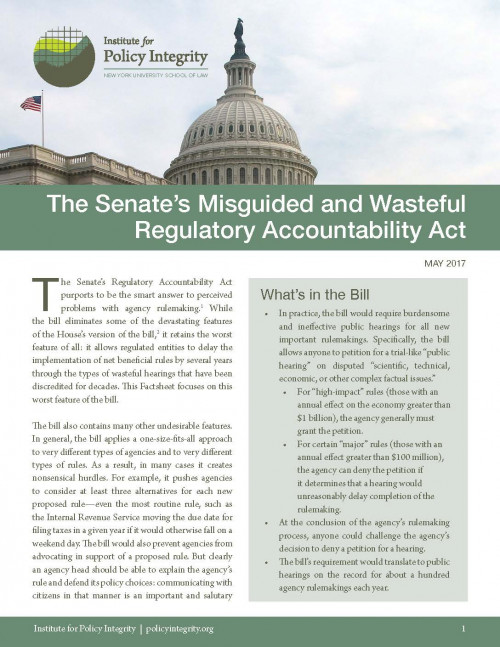-
Resources on Congressional Regulatory Bills
The House of Representatives has passed several bills that could have devastating effects on the federal regulatory process. To help journalists and policymakers understand the potential impact of some bills currently moving through Congress, we recently published a series of fact sheets.
-

The Senate’s Misguided and Wasteful Regulatory Accountability Act
The Senate’s Regulatory Accountability Act would rewrite notice-and-comment rulemaking procedures and create extraordinarily burdensome hurdles in rule implementation by requiring trial-like public hearings. Our issue brief describes how this change to regulatory reform would give opponents of major public safeguards a valuable tool to delay implementation for years, without any regard to the harm that delay would impose on the health and safety of the American public.
-
Comments to the Office of Natural Resources Revenue on the Reform Rule
We recently submitted two sets of comments to the Office of Natural Resources Revenue (ONRR), making the case against repealing an Obama-era reform that promised to recover millions of dollars in royalties from mining companies—a reform that would have ensured that taxpayers receive fair market value for the use of public lands. Our first set of comments objects to the proposed repeal of the Consolidated Federal Oil & Gas and Federal & Indian Coal Valuation Reform Rule (the “Reform Rule”), while our second set responds to ONRR’s request for comments on whether revisions are necessary to the regulations governing coal, oil, and gas royalties. We previously submitted comments to ONRR on the proposed Reform Rule.
-
Comments on U.S. Army Corps of Engineers Environmental Impact Statement
President Trump’s recent executive order on energy disbands the Interagency Working Group on the Social Cost of Carbon (IWG) and withdraws its technical support documents that underpin the IWG’s range of estimates. Instead, the executive order directs federal agencies to continue to monetize the social cost of carbon emissions pursuant to the Office of Management and Budget’s Circular A-4. In our comments, we highlight that the range of estimates from the IWG that agencies have been using, including the number used by the U.S. Army Corps of Engineers in the Draft Environmental Impact Statement, is consistent with Circular A-4 and therefore, consistent with the executive order.
-
California Public Utilities Commission- Comments on Interim Greenhouse Gas Adder
We recently submitted comments to the California Public Utilities Commission on their proposal for an interim greenhouse gas adder. The proposal was for an adder that starts at $0 in 2017 and increases linearly to $250 in 2030. We support the use of a greenhouse gas adder. However, our comments suggest that the Commission instead use an adder based on the Interagency Working Group’s Social Cost of Carbon (“SCC”).
-
California Air Resources Board – Comments on the 2017 Scoping Plan Update
We recently submitted a second set of comments to the California Air Resources Board on its 2017 Climate Change Scoping Plan Update. These comments build on those we submitted in December to ARB on the discussion draft of the scoping plan.
-
Department of Commerce – Comments on Manufacturing and Regulation
We recently submitted comments to the Department of Commerce in response to its request for information on the impact of federal regulations on domestic manufacturing. The DOC requested comments on ideas for retrospective review of permitting and regulatory requirements, with a focus on repealing existing “burdensome” requirements. The agency also sought information about the potential adverse impacts of regulations on manufacturing.
-
Reply Comments on California Distributed Energy Resources Policy
The California Public Utilities Commission proposed using a Societal Cost Test to help select the combination of distributed energy resource projects that will result in the greatest net benefits to society. We counter the feedback that some stakeholders gave on implementing this approach in our reply comments. We argue that the Commission should: (1) expand its discussion of the legal basis for applying a societal cost test that includes a full range of externalities; (2) use the damage cost approach to determine the value of greenhouse gas abatement, rather than the proposed abatement cost approach; and (3) apply a societal discount rate to the analysis.
-
Comments on California’s Evaluation Methods for Distributed Energy Resources
We recently submitted comments to the California Public Utilities Commission (CPUC) on their proposal to develop a more robust societal cost test to evaluate the cost-effectiveness of distributed energy resources (DERs). California has been a national leader in addressing the challenges associated with DER integration, and this proceeding will help the state to reform their cost-effectiveness framework.
-
Toxic Substances Control Act Comments
We recently submitted two sets of comments to the Environmental Protection Agency (EPA) on issues related to the implementation of the recently amended Toxic Substances Control Act (TSCA). The first comment letter focuses on EPA’s proposed restrictions on the manufacture, processing, and distribution of trichloroethylene (TCE) for use in aerosol degreasing and in spot cleaning in dry cleaning facilities. Our second comment letter focuses on EPA’s proposed process for conducting future risk evaluations under the amended TSCA.

